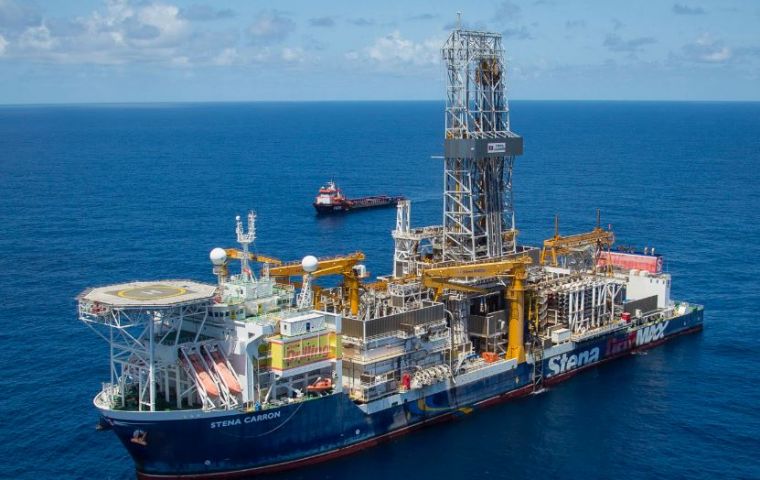MercoPress. South Atlantic News Agency
Guyana: oil and time
 The oil only started flowing in 2019, but per capita GDP has already tripled since then and is likely to triple again in the next ten years.
The oil only started flowing in 2019, but per capita GDP has already tripled since then and is likely to triple again in the next ten years. By Gwynne Dyer – Guyana is not a “hellhole country” of the sort Donald Trump complained about when he said he wanted immigrants to come to the US from white places like Norway instead, but it did used to be poor, tropical and largely populated by people of color.
The people and the climate are still the same, but in terms of wealth Guyana is starting to look more like Norway. Guyana (next to Venezuela, English-speaking, with less than a million people) is on track to overtake Norway as an offshore oil producer within a decade.
The oil only started flowing in 2019, but per capita GDP has already tripled since then and is likely to triple again in the next ten years. That should be making people like President Irfaan Ali very happy, and yet...
“Time is not on our side,” he said last week in Washington, just after a successful auction of eight more offshore blocks for oil and gas exploration off Guyana’s Atlantic coast. They have eleven billion barrels of confirmed reserves and there’s probably lots more to be found, but in ten years it will be late 2033. What will the world look like then?
In particular, what will the international oil market look like then? On the very safe assumption that the impact of climate change will get steadily worse over the next ten years, and the reasonably safe assumption that governments will respond with last-minute attempts to cut carbon dioxide emissions back a lot harder, what will happen to the demand for oil?
Bizarrely, almost nobody in the oil industry is talking about this out loud, but a) the insiders don’t want to damage the market, and b) they have already made their piles anyway. Whereas Guyana is arriving late at the party, and they may be about to take away the punchbowl.
World oil sales will already have stopped growing by 2033, with electric cars legally mandated almost everywhere by 2035. Certainly oil prices will be very shaky as the demand shrinks and the supply doesn’t. So what does the “swing producer” (Saudi Arabia) do then?
A 2021 study led by Dr Jean-François Mercure of Exeter University predicted the rational Saudi response, given that the kingdom’s prosperity and probably also the regime’s survival depend critically on its oil income. What the authors foresaw is that the lowest-cost producers, Saudi Arabia and the other Gulf states, will go for broke.
Nobody can compete with them on price (they can make a profit even when oil costs only US$20 a barrel), so they will flood the world market with cheap oil. The Saudis haven’t done that in the past because they could make much more per barrel if the supply stayed tight, but that’s a long-term perspective and there is no long term for fossil fuels anymore.
If it becomes clear that a lot of oil and gas assets will stay in the ground forever, then it is your patriotic duty to make sure that the stranded assets belong to other countries, not to yours. So drop your price to US$20 a barrel, drive all the higher-cost competitors out of the market, and sell as much oil as you can before demand collapses.
That should be quite a lot, because at US$20 a barrel you will probably still be competitive with renewables. If not, drop your price further. You have nothing to lose.
The authors of the paper calculated that Saudi Arabia could earn US$1.7 trillion before demand completely dries up if it goes the “fire sale” route, compared to only US$1.3 trillion if it cooperates with all the non-Arab members of the OPEC cartel and tries to hold oil and gas prices up; US$400 billion is a big difference, so which way will they jump?
Who goes to the wall first in this scenario? High-cost producers working in tar sands, oil shales, deep water and Arctic areas—so, Canada, the United States, Latin America (mostly Mexico and Brazil) and Russia. But also Guyana, whose oil is five kilometers below the seabed.
This is the sort of scenario that haunts the sharper people in the industry, but they are outnumbered by the complacent ones so there is no stampede for the exit yet. Guyana’s oil production will just be hitting its stride in the early 2030s, so Irfaan Ali is quite right to be worried, but that complacency gives him a safe operating space.
The task for him and his successors is to use the next ten or 15 years of high oil income to transform the country in a sustainable way. Much easier said than done, especially because these calculations are almost impossible to explain to the public, but at least he seems to understand the nature of the task.




Top Comments
Disclaimer & comment rules-

Read all commentsI hope Guyana takes advantage of this bounty better than Ecuador, Venezuela, Bolivia or Colombia did. The bottom of these societies have seen little or no beneficial changes from the hydrocarbon income.
Sep 28th, 2023 - 08:20 pm +1Commenting for this story is now closed.
If you have a Facebook account, become a fan and comment on our Facebook Page!